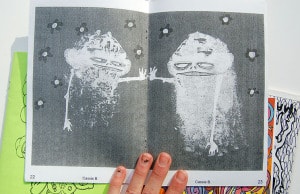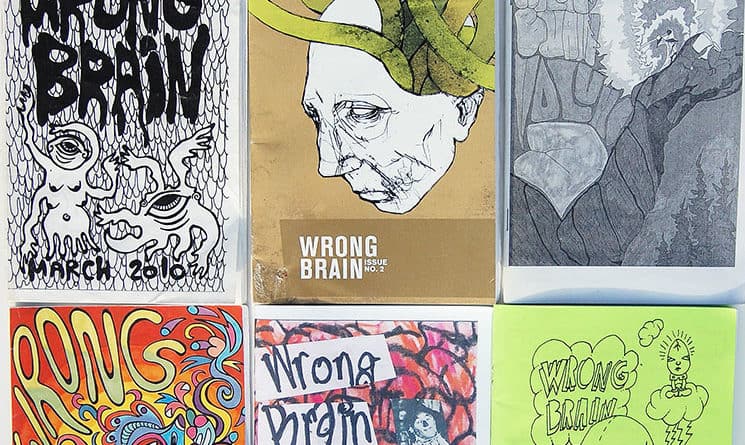When Sam Paolini returned to their hometown of Brentwood after dropping out of the Massachusetts College of Art and Design in 2010, they felt inspired and motivated to begin their career as an artist. But they also felt disconnected from the Seacoast art community and missed the creative atmosphere of Boston’s art scene.
“I didn’t know much about the Seacoast galleries, I was too young to go to shows at bars, and the free publications offered listings about art, but never actual art,” they said.
And so, Paolini started her own publication, Wrong Brain. They put out a call for submissions of art and writing from other “emerging and unconventional artists,” and the response was almost overwhelming. A short time later, Paolini published the first issue of her zine — and found that community they’d been looking for.
“For a few years when I first moved back to New Hampshire, I was always saying, ‘I need to get out of New Hampshire’ and ‘Let’s move to California, let’s move to Portland, let’s move to Providence.’ But, I never could, because I always found myself in the middle of another project, another show, another collaboration,” said Paolini.
Self-published zines have been connecting artists and writers and building subcultures and communities for decades. Hand-made and published in small batches, zines helped shape punk in the 1970s and the riot grrrl scene in the 1990s. They gave a voice to the marginalized, connected the disconnected, and fostered communities and ideas that existed outside the mainstream.
“Zines build communities and affirm the expression and transmission of art.”
And, while it might seem like the Internet and social media killed zines, in the Seacoast, zines are thriving. The writers and artists who produce Wrong Brain are working on their seventh issue and organizing their third annual holiday bazaar. Earth Is Huge and We Are All On It, an online zine based in Dover, is set to release its sixth issue. The publications, meanwhile, are a manifestation of the community each zine has created.
“Zines build communities and affirm the expression and transmission of art,” said Cody Laplante, Wrong Brain’s literary editor. “Zines are a distinct literary and artistic genre that defy all other literary and artistic genres. They can be about anything, composed of any content, and produced in any fashion.”
“Wrong Brain is a hybrid of digital and old school” production, Paolini said. “Most of the layout is done digitally. After that, we’ll print out a master copy, do some hand drawing on the title pages, fill empty corners of pages with poetry, she said. Then we have an assembly party at my place: music, drinks, stapling.”
In the last four years, Paolini and the Wrong Brain crew have put out six issues and three music compilations and hosted a number of art shows and fairs. Wrong Brain’s ranks have swelled to include more than 50 contributors, 10 volunteers, a dozen sponsors, and a three-person editorial staff. Paolini prints 150 to 200 copies of each issue of Wrong Brain and distributes them throughout the Seacoast. It’s a free publication, but to cover costs, Paolini hosts fundraisers and accepts donations. With Wrong Brain’s success, Paolini can’t imagine living anywhere other than New Hampshire.
“It actually scares me now, the thought of moving somewhere else and having to start over making friends and connections and trying to fit in,” they said.
Power of print
Wrong Brain has been successful in print and online, according to Paolini. Digital media has given new life to zines and zine culture, building wider audiences and pushing the medium in new directions. Though some zine-purists argue against going digital, Laplante said the two forms complement each other.
“I think people definitely need to stop seeing print and digital media as opposed,” Laplante said. “Though we no longer need to send out for zine catalogues or subscribe to monthly zines by post, because we can easily find and look at zines from all over the world on the web, that doesn’t mean that we should close down the zine libraries and stop having conventions.”
Some zines, however, are completely digital. Earth Is Huge and We Are All On It published its first issue last May. Georgene Nunn launched Earth Is Huge from her home in Dover with a simple mission statement: “Because your work deserves to be published.” Nunn wants the zine to function as a gathering place in the same way that online communities helped connect her with like-minded people when she was an isolated teenager.
Earth Is Huge is published online using Issuu, a digital platform that gives readers a page-turning experience akin to reading a physical publication. Even though she works primarily with digital media, Nunn doesn’t brush aside the power print still has. In fact, she’s a huge fan of Wrong Brain since discovering a copy in a café. “It was inspiring in a way the online experience can’t be, because in that simple stack of paper was a visceral connection to place, time and people.”
Like Paolini and Laplante, Nunn thinks zines will continue to remain an important part of local art scenes, no matter what form they take.
“Regardless of the distribution method, the cultural legacy of the zine is pretty powerful. Zines shine at human touch and rawness, being cover-to-cover attempts to showcase creativity outside the lines,” said Nunn. “The legacy of the zine is one of thumbing noses at convention in favor of self expression, regardless of how raw or rude.”

You can find Wrong Brain online at wrongbrain.net and Earth is Huge at earth-is-huge-mag.tumblr.com. Wrong Brain’s third-annual Holidaze Bizarre takes place Saturday, Dec. 13, from 11 a.m. to 5 p.m. at the Millspace in Newmarket.

